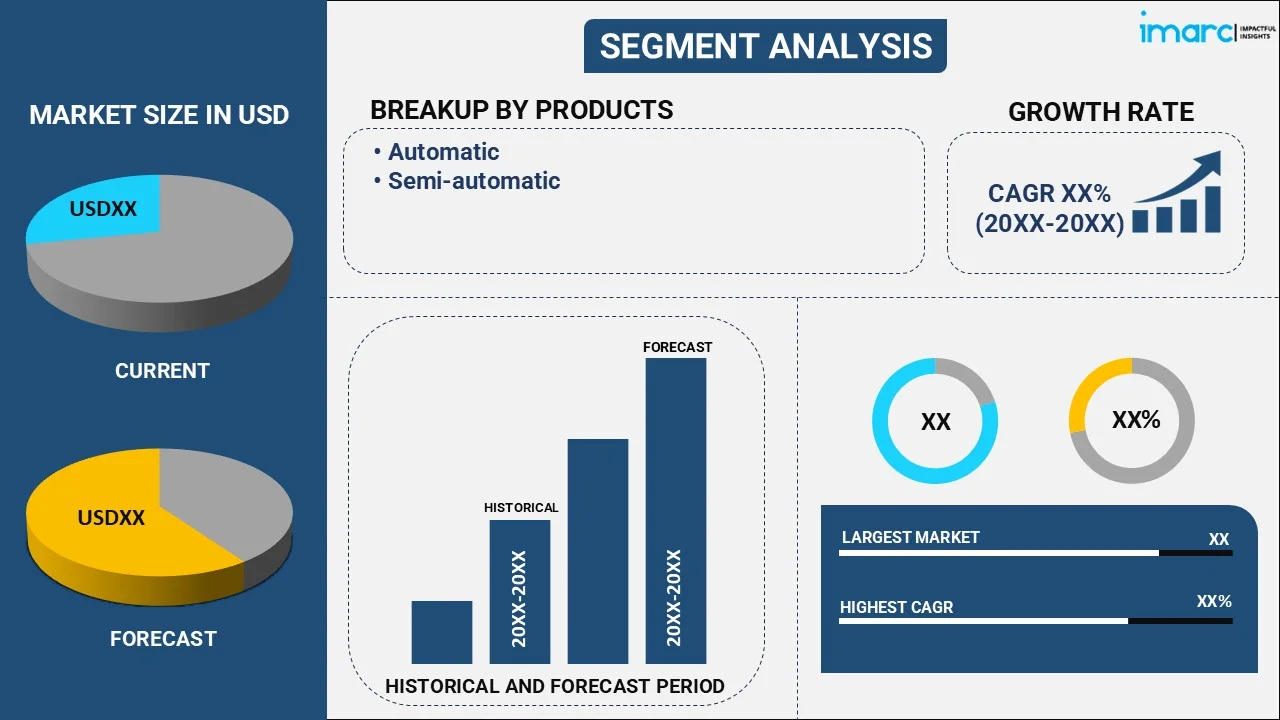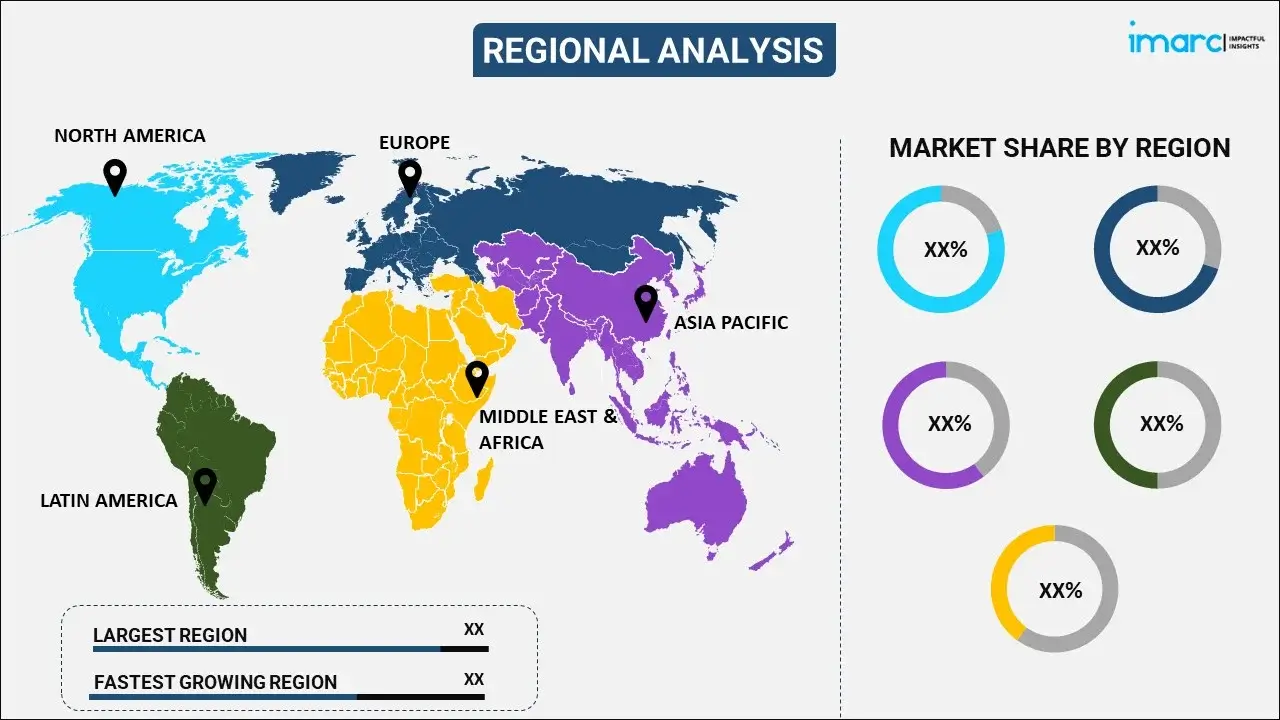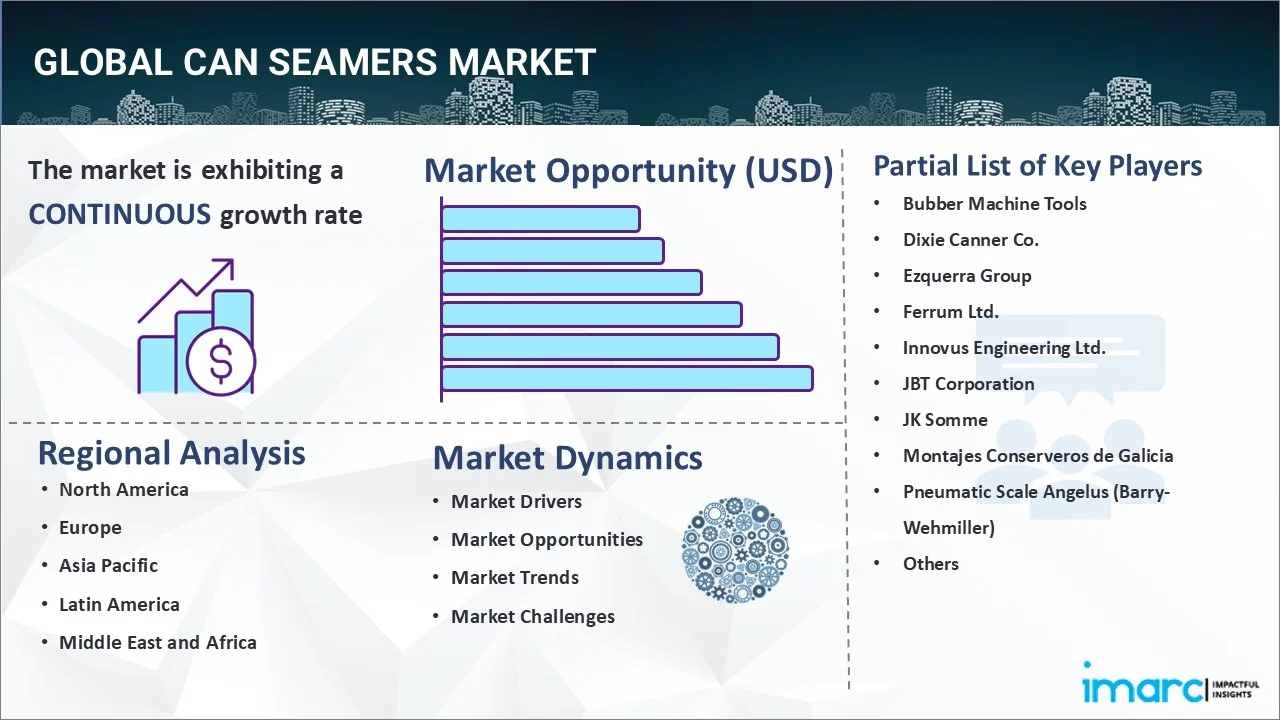
Can Seamers Market Report by Product (Automatic, Semi-automatic), Application (Beverage, Food, and Others), and Region 2025-2033
Can Seamers Market Size:
The global can seamers market size reached USD 598.8 Million in 2024. Looking forward, IMARC Group expects the market to reach USD 916.1 Million by 2033, exhibiting a growth rate (CAGR) of 4.84% during 2025-2033. The market is experiencing steady growth driven by rising consumer demand for packaged foods and beverages, the rising shift towards sustainable packaging aligning with environmental regulations and consumer preferences, and continuous technological advancements in can seaming machinery.
|
Report Attribute
|
Key Statistics
|
|---|---|
|
Base Year
|
2024 |
|
Forecast Years
|
2025-2033
|
|
Historical Years
|
2019-2024
|
| Market Size in 2024 | USD 598.8 Million |
| Market Forecast in 2033 | USD 916.1 Million |
| Market Growth Rate (2025-2033) | 4.84% |
Can Seamers Market Analysis:
- Major Market Drivers: The increasing demand for packaged food and beverages due to changing consumer lifestyles and rapid urbanization is driving the market. Additionally, improvements in can seaming machinery to make operations efficient are further fueling the market.
- Key Market Trends: The escalating integration of IoT and AI technologies within can seamers for predictive maintenance and real-time monitoring is one of the major trends. Besides, the shift in preference to aluminum cans over their plastic and glass counterparts to meet recyclability and sustainability goals is acting as another trend.
- Geographical Trends: According to the can seamers market research report, North America and Europe are considered to lead the market as a reflection of the high consumption of canned drinks and the advanced adoption of technology. In Asia-Pacific and other countries, growing economies display rapid developments in the market due to high levels of urbanization and the increase in disposable income.
- Competitive Landscape: The market is competitive, and key companies focus on technological innovations through strategic collaborations. Companies invest in R&D to offer advanced can-seaming solutions that fit different industry needs. Some of the key players include Bubber Machine Tools, Dixie Canner Co., Ezquerra Group, Ferrum Ltd., Innovus Engineering Ltd., JBT Corporation, JK Somme, Montajes Conserveros de Galicia, Pneumatic Scale Angelus (Barry-Wehmiller), Shin-I Machinery Works Co., Ltd., Stiller GmbH, Swiss Can AG, and Zilli & Bellini S.r.l.
- Challenges and Opportunities: The implementation of strict environmental regulations and the continuing public pressure are some of the market challenges. On the contrary, innovation toward "state-of-the-art" efficient machinery development and in development of eco-friendly canning solutions act as major opportunities.
Can Seamers Market Trends:
Growing demand for packaged foods and beverages
The rising consumption of ready-to-eat foods and beverages is a major factor supporting the market. Increasing urbanization and changing preferences of the consumer for convenience foods due to fast-paced life are increasing acceptance of canned products and thus are available on the shelf. These encourage the cycle with improved food preservation technologies and shelf-stability from canned goods. Therefore, this is propelling the market. Additionally, the highest consumer of canned products is the beverage industry, specifically the craft beer and energy drinks segment, which makes high-quality can seaming necessary for this sector. Moreover, increasing recognition of the advantages associated with canned food such as maintenance of nutrients and decreased food wastage is also aiding in escalating can seamers demand, thereby continuing to drive the market growth.
Technological advancements in can seaming machinery
The market is supported by advancements in productivity and quality of the products. Can seamers come with state-of-the-art features such as automatic control systems, real-time monitoring, and tolerance testing to eliminate inconsistency in seams and improve quality. Along with this, these technological advancements minimize the risk of product contamination and spoilage, complying with strict safety and quality regulations. Concurrently, can seamers are enabled with IoT and AI for predictive maintenance to minimize downtime and costs. This technological advance increases efficiency and responds to the demand for different can sizes and designs- features that render these machines very versatile in terms of industrial applications. Thus, this is further creating a positive can seamers market outlook.
Rising sustainability and environmental concerns
A key factor that stimulates the demand in the can seamers market is growing awareness about sustainability and environmental consciousness. In addition, the escalating reutilization of aluminum cans and packages due to the rising concerns regarding the use of plastic is significantly supporting the market. Increasing pressure on manufacturers by governments, and regulatory bodies authorities across the globe to implement stringent norms to reduce plastic utilization is one of the major factors driving the growth of the market. Its easy recyclability ties in well with the principles of the circular economy and drives can seamers market value. This environmental sensitivity is making the manufacturers install a productive can seaming machine adapted for sustainable packaging solutions. Moreover, innovations characterized by lowered carbon footprints in can production and seaming processes are propelling the industry towards global sustainability goals while supporting the appeal of canned product manufacturers amid environment aficionados. Consequently, companies are increasingly investing in advanced can seamer technologies to enhance their production efficiency and meet the growing demand for eco-friendly packaging solutions. By adopting cutting-edge technology, manufacturers can achieve higher precision in sealing, reduce operational costs, and ensure the integrity and quality of their products.
Can Seamers Market Segmentation:
IMARC Group provides an analysis of the key trends in each segment of the market, along with forecasts at the global, regional, and country levels for 2025-2033. Our report has categorized the market based on product and application.
Breakup by Product:

- Automatic
- Semi-automatic
Semi-automatic accounts for the majority of the market share
The report has provided a detailed breakup and analysis of the market based on the product. This includes automatic and semi-automatic. According to the report, semi-automatic represented the largest segment.
The largest category in the global can seamers market is the semi-automatic can seamers segment due to its best compromise of efficiency and flexibility suited to small and medium enterprises (SMEs) as well as artisanal producers. Semi-automatic seamers offer an affordable option for consistent sealing quality without the required investment in a comprehensive automation infrastructure that many smaller operations cannot afford. These machines are manual, and there is an opportunity for users to get involved in the sealing process, making them perfect if they use a lot of different can sizes or designs. Therefore, this is further favoring the can seamers market revenue. In addition, less maintenance and operational expenses compared to fully automatic systems are a valued resource for most manufacturers that therefore prefer semi-automatic seamers. Apart from this, the presence of semi-automatic can seamers is increasing on account of these industries' emphasis and preference for utilizing this machine's versatility, as well as within food applications such as craft beverages or specialty items. Hence, it dominates among the most supplied segments as its diversity and affordability make sustainable growth effective.
Breakup by Application:
- Beverage
- Food
- Others
Beverage holds the largest share of the industry
The report has provided a detailed breakup and analysis of the market based on the application. This includes beverage, food, and others. According to the report, beverage represented the largest segment.
The can seamers market research report suggests that demand for canned beverages holds particularly high while contributing prominently to the growth of the beverage segment enabled by sales and increasing consumption. Some of these beverages include carbonated drinks, energy drink products, as well as alcoholic beverages such as beer and cider, including a larger number of health-flavored waters. Consumers drink canned beverages as they find them more convenient, less heavy to carry around and have a longer shelf life. Moreover, the inclination toward craft and artisanal drinks such as beer (mainly craft) has considerably driven canning solutions efficiently. In such a situation, seaming plays an important role in safeguarding the quality and safety of these beverages by ensuring carbonation levels remain intact throughout shelf life while also preventing contamination. In addition, the launch of a wide variety of designs in cans, along with an increased emphasis on sustainability (with aluminum being the recyclable material compared to plastic for bottles), further strengthens this segment. The beverage application segment continues to account for a leading share of the global market, as manufacturers in the metal packaging industry consolidate their positions while striving to satiate consumer demand for diverse and premium products according to the can seamers market overview.
Breakup by Region:

- North America
- United States
- Canada
- Europe
- Germany
- France
- United Kingdom
- Italy
- Spain
- Others
- Asia Pacific
- China
- Japan
- India
- South Korea
- Australia
- Indonesia
- Others
- Latin America
- Brazil
- Mexico
- Others
- Middle East and Africa
Asia Pacific leads the market, accounting for the largest can seamers market share
The report has also provided a comprehensive analysis of all the major regional markets, which include North America (the United States and Canada); Europe (Germany, France, the United Kingdom, Italy, Spain, and others); Asia Pacific (China, Japan, India, South Korea, Australia, Indonesia, and others); Latin America (Brazil, Mexico, and others); and the Middle East and Africa. According to the report, Asia Pacific represents the largest regional market for can seamers.
Asia Pacific leads the global market based on geography, which is attributed to rapid urbanization and economic development in the APAC region along with increasing disposable incomes. This region comprises the most populous countries in the world, such as China and India, that are witnessing a rapidly growing middle class along with subsequent higher demand for the packaging of food and beverages. Along with this, the rise in growth within numerous areas of the expanding beverage sector, such as canned soft drinks, energy drinks, and alcoholic beverages, which translates to significant demand for advanced canning solutions. According to the can seamers market forecast, robust sales of can seamer machines are expected in East Asia, where small to medium-sized enterprises and large manufacturers located across Japan, South Korea, and Australia continue driving market growth. Increasing technological advancements and the various steps taken by governments to promote sustainable packaging are further boosting the market in this region. Furthermore, can seaming technology will continue to experience growth and innovation due to the growing preference for eco-friendly packaging alternatives and robust investments in manufacturing infrastructure. As a result, APAC continues to account for a significant market share, and consumer preference along with high industrial practices in the region is positively influencing can seamer sales.
Competitive Landscape:
The market research report has also provided a comprehensive analysis of the competitive landscape in the market. Detailed profiles of all major companies have also been provided. Some of the major market players in the can seamers industry include:
- Bubber Machine Tools
- Dixie Canner Co.
- Ezquerra Group
- Ferrum Ltd.
- Innovus Engineering Ltd.
- JBT Corporation
- JK Somme
- Montajes Conserveros de Galicia
- Pneumatic Scale Angelus (Barry-Wehmiller)
- Shin-I Machinery Works Co., Ltd.
- Stiller GmbH
- Swiss Can AG
- Zilli & Bellini S.r.l.
(Please note that this is only a partial list of the key players, and the complete list is provided in the report.)
Leading manufacturers of can seamers are concentrating on innovation, collaborative endeavors, and the latest product launches to strengthen their competitive edge. As a result, can seamers companies are investing significantly in R&D to offer forth next-generation automatic can seaming solutions with integration capabilities such as IoT and AI, improved efficiency and precision. These businesses often team up or merge in order to expand their market footprint and gain the benefits of shared technological advancements. Leading producers are also showing their commitment to sustainability at a time when manufacturers are increasingly interested in eco-friendly packaging solutions, making environmentally friendly can seamers which contribute significantly as recyclable aluminum cans become more widely produced. Moreover, several crucial manufacturers are increasingly establishing their market footing in developing regions such as the APAC to leverage the high consumption trend among consumers for packaged food and beverages.
Can Seamers Market News:
- May 01, 2024: JBT, a leading global food and beverage corporation technology solutions provider announced the launch of SeamTec 2 Evolute, type of can seamer specifically designed for powder products. According to the company, the latest version delivers major advantages in hygienic design and cleanability, ergonomics, and machine simplicity as well as retains core qualities for powders- spill containment, bag range changes-minimum downtime (small-to-large) with explosion-proofing integrated.
- September 7, 2023: Pneumatic Scale Angelus (PSA), a BW Packaging company has introduced its CB100R craft canning line at Pack Expo Las Vegas. The most recent of PSA's canning lines for craft beverages, the CB100R, combines rotary counter-pressure filling with rotary Angelus seaming in a layout that operates at over 100 cans per minute (CPM).
Can Seamers Market Report Scope:
| Report Features | Details |
|---|---|
| Base Year of the Analysis | 2024 |
| Historical Period | 2019-2024 |
| Forecast Period | 2025-2033 |
| Units | Million USD |
| Scope of the Report | Exploration of Historical Trends and Market Outlook, Industry Catalysts and Challenges, Segment-Wise Historical and Future Market Assessment:
|
| Products Covered | Automatic, Semi-automatic |
| Applications Covered | Beverage, Food, Others |
| Regions Covered | Asia Pacific, Europe, North America, Latin America, Middle East and Africa |
| Countries Covered | United States, Canada, Germany, France, United Kingdom, Italy, Spain, China, Japan, India, South Korea, Australia, Indonesia, Brazil, Mexico |
| Companies Covered | Bubber Machine Tools, Dixie Canner Co., Ezquerra Group, Ferrum Ltd., Innovus Engineering Ltd., JBT Corporation, JK Somme, Montajes Conserveros de Galicia, Pneumatic Scale Angelus (Barry-Wehmiller), Shin-I Machinery Works Co., Ltd., Stiller GmbH, Swiss Can AG, Zilli & Bellini S.r.l., etc. |
| Customization Scope | 10% Free Customization |
| Post-Sale Analyst Support | 10-12 Weeks |
| Delivery Format | PDF and Excel through Email (We can also provide the editable version of the report in PPT/Word format on special request) |
Key Questions Answered in This Report:
- How has the global can seamers market performed so far, and how will it perform in the coming years?
- What are the drivers, restraints, and opportunities in the global can seamers market?
- What is the impact of each driver, restraint, and opportunity on the global can seamers market?
- What are the key regional markets?
- Which countries represent the most attractive can seamers market?
- What is the breakup of the market based on the product?
- Which is the most attractive product in the can seamers market?
- What is the breakup of the market based on the application?
- Which is the most attractive application in the can seamers market?
- What is the competitive structure of the market?
- Who are the key players/companies in the global can seamers market?
Key Benefits for Stakeholders:
- IMARC’s industry report offers a comprehensive quantitative analysis of various market segments, historical and current market trends, market forecasts, and dynamics of the can seamers market from 2019-2033.
- The research report provides the latest information on the market drivers, challenges, and opportunities in the global can seamers market.
- The study maps the leading, as well as the fastest-growing, regional markets. It further enables stakeholders to identify the key country-level markets within each region.
- Porter's five forces analysis assists stakeholders in assessing the impact of new entrants, competitive rivalry, supplier power, buyer power, and the threat of substitution. It helps stakeholders to analyze the level of competition within the can seamers industry and its attractiveness.
- The competitive landscape allows stakeholders to understand their competitive environment and provides insight into the current positions of key players in the market.
Need more help?
- Speak to our experienced analysts for insights on the current market scenarios.
- Include additional segments and countries to customize the report as per your requirement.
- Gain an unparalleled competitive advantage in your domain by understanding how to utilize the report and positively impacting your operations and revenue.
- For further assistance, please connect with our analysts.

 Request Customization
Request Customization
 Speak to an Analyst
Speak to an Analyst
 Request Brochure
Request Brochure
 Inquire Before Buying
Inquire Before Buying




.webp)




.webp)












